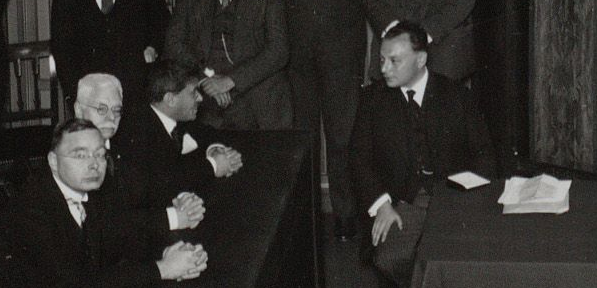Reminiscence of the awarding of the Lorentz medal to Wolfgang Pauli in 1931

From left to right: Hendrik Kramers, Pieter Zeeman, Paul Ehrenfest, and Wolfgang Pauli, at the award ceremony.
I think the most amusing -and least known- battle of wits between Pauli and Ehrenfest was the one in connection with the awarding of the Lorentz Medal of the Royal Netherlands Academy of Arts and Sciences to Pauli on 31 October 1931. Ehrenfest had written to Pauli that it would be appreciated if he would appear in a black suit. Pauli replied by postcard, dated Zürich, 26 October 1931.
Dear Ehrenfest,
Just now I ordered a new black suit at my tailor's. But I shall only put it on at Amsterdam, if you promise me to thank me in public, in your official allocution at the Academy, for not having saved myself the trouble of going to the tailor....How did Ehrenfest comply with this condition? I quote from his address:
At first sight the Pauli principle would seem to concern only those, who occupy themselves with the details of the distribution of electrons in Bohr-atoms, or with their spectra. And the title of your paper seems to confirm this impression. For it is "Ueber den Zusammenhang des Abschlusses der Electronengruppen im Atom mit der Komplex-Struktur der Spectren." But, for all its esoteric appearance, this principle does exert its influence in the midst of our everyday world. It is fascinating to make this clear to ourselves by a simple example.
We take up a piece of metal. Or a stone. A little thought will make us wonder why this quantity of matter does not occupy far less space. Certainly, the molecules are very closely packed. And so are the atoms in the molecule. -All right- But why are the atoms themselves as thick as they are?
Let us look for example at the Bohr model for a lead atom. Why are only very few of the 82 electrons circulating in quantum-orbits close to the nucleus and all others in ever more remote orbits? For the attraction of the 82 positive units of charge of the atomic nucleus is so powerful. Many more of the 82 electrons could come together on the inner orbits before their mutual repulsion gets too large. What then prevents the atom from making itself smaller in that way?! Answer: Only the Pauli principle: "No two electrons in the same quantumstate." Therefore the atoms so unnecessarily thick: Therefore the stone, the piece of metal, etc. so voluminous. You will have to concede, Herr Pauli, by partially waiving your exclusion principle you might free us from many worries of daily life, for instance from the traffic problem in our streets.
So says the printed version, but in his speech Ehrenfest added something like "and you might also considerably reduce the expenditure for a beautiful, new, formal black suit." I attended the ceremony in the spectators' balcony in the Academy, but I do not remember the exact wording. It was just one sentence and it certainly contained the words "schöne, neue, schwarze Festkleidung"; "Und wie man die Auslagen für schöne, neue schwarze Festkleidung herabsetzen kann" should be fairly close. I do remember Pauli's grin and the approving increase of the amplitude of oscillation of his body.
H.B.G. Casimir, Haphazard Reality (Harper & Row, New York, 1983)